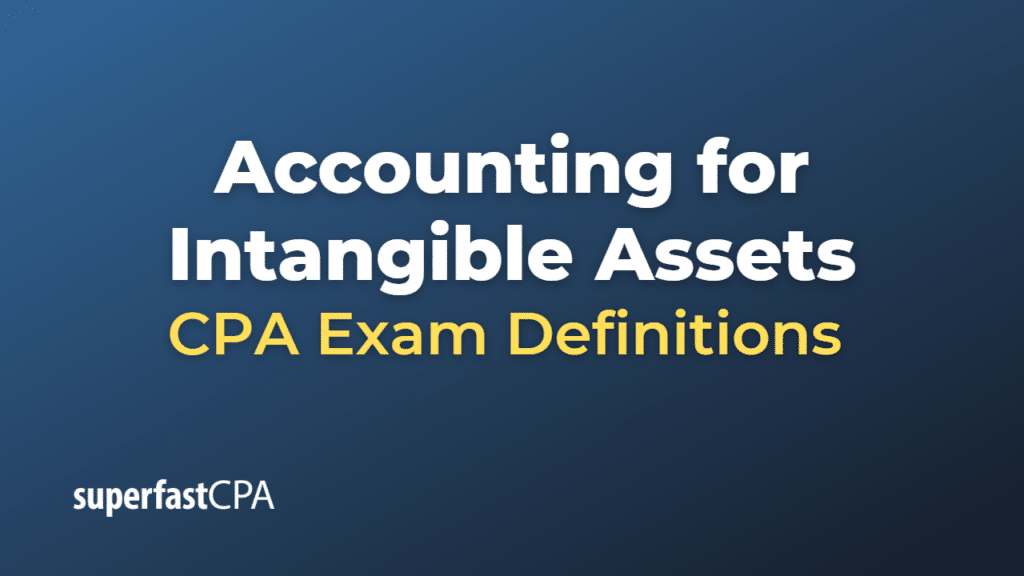Accounting for Intangible Assets
Accounting for intangible assets involves the identification, recognition, measurement, amortization, and disclosure of intangible assets in a company’s financial statements. Intangible assets are non-physical assets that have economic value, provide future benefits, and are identifiable and controlled by the company. Examples of intangible assets include patents, trademarks, copyrights, customer relationships, and software.
Under U.S. Generally Accepted Accounting Principles (GAAP) and International Financial Reporting Standards (IFRS), intangible asset accounting is primarily governed by FASB’s ASC Topic 350 and IAS 38, respectively.
Here are the key steps in accounting for intangible assets:
- Identification: Determine whether the asset meets the definition of an intangible asset, i.e., it is non-physical, identifiable, has economic value, and provides future benefits.
- Recognition: Intangible assets can be acquired through purchase, internal development, or through a business combination. The recognition criteria depend on the mode of acquisition:a. Purchased intangible assets: Recognize the asset at its cost, which includes the purchase price and any directly attributable costs of acquisition.b. Internally developed intangible assets: Recognize the asset if it meets specific criteria, such as technical feasibility, intention to complete, and the ability to generate future economic benefits. The asset is measured at the sum of the costs incurred during the development phase.c. Business combination: Recognize the asset at its fair value at the acquisition date, separate from goodwill.
- Measurement: After initial recognition, intangible assets can be measured using either the cost model or the revaluation model:a. Cost model: The asset is carried at its cost less accumulated amortization and any accumulated impairment losses.b. Revaluation model (allowed under IFRS, not under U.S. GAAP): The asset is carried at its fair value at the revaluation date less any subsequent accumulated amortization and accumulated impairment losses. Revaluation gains and losses are generally recognized in other comprehensive income and accumulated in equity.
- Amortization: Intangible assets with finite useful lives are amortized on a systematic basis over their useful lives, with the amortization expense recognized in the income statement. Intangible assets with indefinite useful lives (e.g., certain trademarks) are not amortized but tested for impairment annually.
- Impairment: Assess intangible assets for impairment at least annually or whenever there is an indication that the asset may be impaired. If the carrying amount of the asset exceeds its recoverable amount (the higher of its fair value less costs to sell and its value in use), recognize an impairment loss in the income statement.
- Disclosure: Disclose information about the nature, carrying amounts, useful lives, amortization methods, and other relevant details of intangible assets in the notes to the financial statements.
By accounting for intangible assets properly, a company provides users of its financial statements with an accurate representation of the company’s financial position and performance, considering the economic value and future benefits of its intangible assets.
Example of Accounting for Intangible Assets
Let’s consider an example of a company accounting for a purchased intangible asset, specifically a patent.
Example: ABC Corporation purchases a patent for a new technology for $200,000. The patent has a legal life of 20 years and is expected to generate economic benefits for the company for 10 years. The company will use the straight-line method for amortization.
Here’s how ABC Corporation would account for the patent:
Step 1:
Identification: The patent is an intangible asset as it is non-physical, identifiable, has economic value, and provides future benefits.
Step 2:
Recognition: Since the patent is purchased, ABC Corporation recognizes the patent at its cost, which is $200,000.
Step 3:
Measurement: ABC Corporation will use the cost model to measure the patent. The initial carrying amount is $200,000.
Step 4:
Amortization: The patent has a finite useful life of 10 years. ABC Corporation will amortize the patent using the straight-line method:
| $200,000 (patent cost) ÷ 10 (useful life) = $20,000 (annual amortization expense) |
Each year, ABC Corporation records the following journal entry for amortization:
| Debit: Amortization Expense (Patent) | $20,000 |
| Credit: Accumulated Amortization | $20,000 |
Step 5:
Impairment: ABC Corporation assesses the patent for impairment annually or whenever there is an indication that the patent may be impaired. If an impairment loss is identified, it would be recognized in the income statement.
Step 6:
Disclosure: ABC Corporation discloses information about the patent, its carrying amount, useful life, amortization method, and any impairment losses in the notes to the financial statements.
By properly accounting for the patent, ABC Corporation provides users of its financial statements with an accurate representation of the company’s financial position and performance, considering the economic value and future benefits of the patent.












